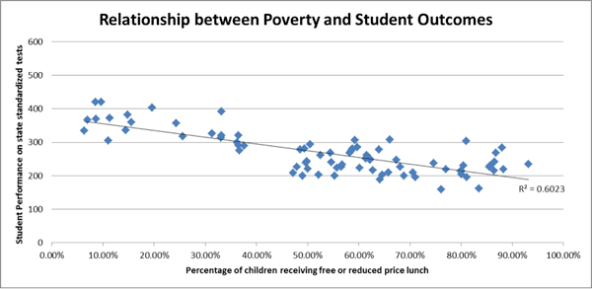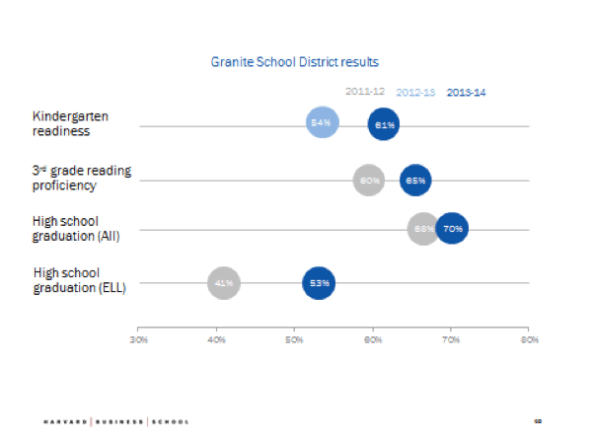Business leaders acknowledge that excellent public education in the United States is critical to social equity, as well as economic growth and shared prosperity. More than half of business leaders surveyed recently by the US Competitiveness Project at Harvard Business School believe that education-related issues are both a cause of and a remedy to limited economic mobility in the United States; almost 40 percent see changes in education as a way to address increasing poverty. They recognize that young people impacted by poverty must receive a high-quality education to realize their potential.
Poverty’s negative impact on student performance is well-established. As illustrated below, there is a strong relationship between a school’s average standardized test scores and the percentage of students in that school eligible to receive free or reduced-price lunch, a measure of poverty. (Students living in four-person households earning between $31,525 and $44,863 are eligible for reduced-price lunch; those earning $31,525 or below are eligible for free lunch.)
 Data from the 2013-14 Utah Comprehensive Accountability System (UCAS) Report for 79 elementary and middle schools in one Utah school district. (Image courtesy of United Way of Salt Lake)
Data from the 2013-14 Utah Comprehensive Accountability System (UCAS) Report for 79 elementary and middle schools in one Utah school district. (Image courtesy of United Way of Salt Lake)
The support a student receives outside the classroom often materially impacts their performance inside the classroom. While middle-income and affluent parents have the resources to provide their children with a range of needed services, such as math tutoring and psychological counseling, lower-income families usually don’t. And while more than 87,000 nonprofits, as well as many local government programs, aim to support youngsters impacted by poverty, they often operate in isolation, lack shared goals, and have little ability to measure effectiveness. Program quality often varies considerably, and service redundancies exist alongside service gaps, diluting the overall impact of the programs.
The net result is service delivery chaos.
Are you enjoying this article? Read more like this, plus SSIR's full archive of content, when you subscribe.
Many well-intentioned businesses inadvertently help perpetuate this chaotic situation. US businesses contribute $3-4 billion per year to support public education, either through nonprofits or directly to schools. Despite these generous contributions and countless volunteer hours to improve educational outcomes, particularly for children living in poverty, too often business support is not based on outcome data or coordinated with nonprofits, local government, and others delivering services in the community. As a result, mediocre programs continue to exist even when superior programs are available, and multiple competing programs meet some student needs but leave other needs unaddressed. Business support also typically focuses on one point of the learning continuum, such as third-grade reading or job internships. When these programs are not part of an integrated system of supports, over time the gains achieved may erode or disappear altogether.
Businesses could greatly enhance their effectiveness by working to improve all aspects of the educational ecosystem in partnership with community leaders, families, nonprofits, school districts, and government. The broad, cross-sector coordination at the heart of the collective impact approach provides an innovative process and structure for creating deep and unprecedented partnerships.
To better understand the role business can play in supporting collective impact efforts, we interviewed more than 60 collective impact practitioners, business leaders, and others involved in collaborative education initiatives, and conducted the first national survey of both initiative leaders and the business leaders who serve on their leadership councils.
Many of these collective-impact initiatives are relatively new, but a number are making progress toward their goals. For example, one large district in the Salt Lake region—where a collective-impact initiative has been contributing to growing academic gains for children impacted by poverty since 2011—has seen increases in kindergarten readiness, third-grade reading proficiency, and high-school graduation rates.
They have experienced particularly dramatic increases in graduation rates for English language learners (those whose second language is English), despite poverty rates in the district approaching 60 percent.
 Granite School District results, 2011-12 to 2013-14. (Image courtesy of United Way of Salt Lake)
Granite School District results, 2011-12 to 2013-14. (Image courtesy of United Way of Salt Lake)
The United Way of Salt Lake, with the strong backing of its business-led board, shifted to a collective impact model from the more-traditional United Way business model. It developed partnerships with the nonprofit community and engaged other community stakeholders, including local government and school district leaders. No single program or group drove improvements, and the backbone organization, established as part the United Way, facilitated the work. The partnerships’ ongoing efforts fall into three main categories: expanding learning opportunities, improving core instruction, and providing comprehensive health-related services. While educators have been important to improving classroom instruction, community partners have played the central role in expanding out-of-school learning opportunities and providing health-related services.
Business has been involved at every level. For example, Savage Industries, a supply-chain company headquartered in Salt Lake, grants employees paid time off to volunteer in credit-recovery classes for ninth graders who failed core courses, helping these students stay on track for high school graduation. In the school where Savage Industries employees volunteer, the number of ninth graders completing their core courses increased from 25 percent in 2012 to 53 percent in 2014.The CEO, himself a tutor, also helped the backbone leadership hone and refine its strategy.
The initiative leaders we surveyed overwhelmingly confirmed the importance of business engagement in their initiatives, with 96 percent responding that business was either critical or very important to their work. In the widely known Cincinnati-region StrivePartnership initiative, for example—one of the first collective impact initiatives focused on supporting students from “cradle to career”—business leaders were involved in the initial planning and remain involved today. The chairman of Procter & Gamble was part of original leadership council, and GE Avionics, a division of General Electric based in Cincinnati, worked with the other organizations in the collaborative to adapt its proven Six Sigma approach to achieving continuous improvement, to the work of nonprofits. In the process, GE helped build unprecedented trust between business and other sectors, and strengthened the capacity of all involved. Continuous improvement, with its focus on measuring outcomes against objectives to drive improvement, has become foundational to collective impact, particularly for the 64 communities in the StriveTogether network. With a poverty rate of 72 percent, the number of fourth graders reading at proficiency in Cincinnati has increased from 55 percent to 76 percent since 2004, and eighth-grade math proficiency has improved 24 percentage points over the same period. High school graduation rates are up 14 percentage points since 2011.
We also learned that in addition to business leaders’ desire to improve public education, they support collective impact initiatives because of their focus on measurable outcomes, use of data-driven decision-making, and potential to change how educators and the community work together toward shared goals.
Scott Ulbrich, a local business leader participating in Salt Lake’s education initiative told us, “This is a long-term social change effort. It is common sense that isolated interventions do not solve problems. People ‘get’ [collective impact] and want to invest in it. Business has accepted the invitation to engage with educators to change systems.”
Developing collective impact partnerships takes time and effort from all parties, but the payoff can be powerful. And while involving business isn’t a prerequisite for success, the business community’s support and expertise can greatly enhance the odds. Transformation of the education ecosystem is important to sustained improvement in education outcomes. Business leaders want to see improvements in inequality, poverty, and economic mobility, as well as a higher-skilled workforce. They also see education as both a cause of and a solution to these economic challenges, and through collective impact, they can multiply the effectiveness of their efforts.
Support SSIR’s coverage of cross-sector solutions to global challenges.
Help us further the reach of innovative ideas. Donate today.
Read more stories by Ann Lombard & Allen Grossman.

